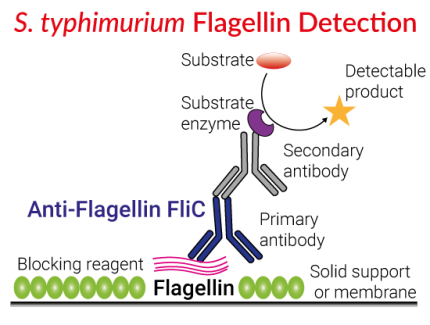
Anti-Flagellin FliC
-
Cat.code:
mabg-flic-2
- Documents
ABOUT
Monoclonal antibody against S. typhimurium flagellin
Anti-Flagellin FliC (clone X5A12) is a monoclonal mouse IgG1 antibody against flagellin from Salmonella typhimurium. This antibody was generated by DNA immunization of Balb/c mice with the fliC gene. It has been produced in hybridomas and purified by affinity chromatography.
Anti-Flagellin FliC was screened for its ability to bind purified flagellin from S. typhimurium (FLA-ST) using ELISA. Flagellin is the major component of the bacterial flagellar filament, which confers motility on a wide range of bacterial species. Flagellin is recognized by TLR5 [1] and induces the activation of NF-κB and the production of cytokines and nitric oxide depending on the nature of the TLR5 signaling complex [2].
Key features:
- Reacts with purified and recombinant flagellin from S. typhimurium
- Provided azide-free
- Each lot is functionally tested
References:
1. Hayashi F. et al., 2001. The innate immune response to bacterial flagellin is mediated by Toll-like receptor 5. Nature. 410(6832):1099-103.
2. Mizel SB. et al., 2003. Induction of macrophage nitric oxide production by Gram-negative flagellin involves signaling via heteromeric Toll-like receptor 5/Toll-like receptor 4 complexes. J Immunol. 170(12):6217-23.
All products are for research use only, and not for human or veterinary use.
SPECIFICATIONS
Specifications
Flagellin FliC
Western blot (tested), ELISA (tested)
Sodium phosphate buffer with glycine, saccharose, and stabilizing agents
0.2 µm filtration
Each lot is functionally tested and validated.
CONTENTS
Contents
-
Product:Anti-Flagellin FliC
-
Cat code:mabg-flic-2
-
Quantity:2 x 100 µg
Shipping & Storage
- Shipping method: Room temperature
- -20°C
- Avoid repeated freeze-thaw cycles
Storage:
Caution:
Details
Flagellin is the major component of the bacterial flagellar filament, which confers motility to a wide range of bacterial species. This proinflammatory molecule is present in both Gram-negative and Gram-positive bacteria. It is recognized by distinct types of pattern recognition receptors (PRRs).
Extracellular flagellin is recognized by surface-localized Toll-like receptor 5 (TLR5), which promotes the activation of NF-κB and the subsequent production of cytokines [1, 2]. Flagellin is also recognized by the cytosolic NOD-like receptors (NLRs) NAIP5/NAIP6 sensors of the NLRC4 inflammasome [3, 4]. Flagellin monomers are translocated into the host cell cytosol by a mechanism that requires bacterial secretion systems. This triggers the formation of an NAIP-NLRC4 inflammasome leading to caspase-1-mediated secretion of IL-1β and IL-18 [3, 4].
1. Song WS. et al., 2017. A conserved TLR5 binding and activation hot spot on flagellin. Sci Rep. 7:40878.
2. Hayashi F. et al., 2001. The innate immune response to bacterial flagellin is mediated by Toll-like receptor 5. Nature. 410(6832):1099-103.
3. Duncan JA. & Canna SW., 2018. The NLRC4 Inflammasome. Immunol Rev. 281(1):115-123.
4. Zhao Y. et al., 2011. The NLRC4 inflammasome receptors for bacterial flagellin and type III secretion apparatus. Nature. 477(7366):596-600.
DOCUMENTS
Documents
Technical Data Sheet
Safety Data Sheet
Certificate of analysis
Need a CoA ?


